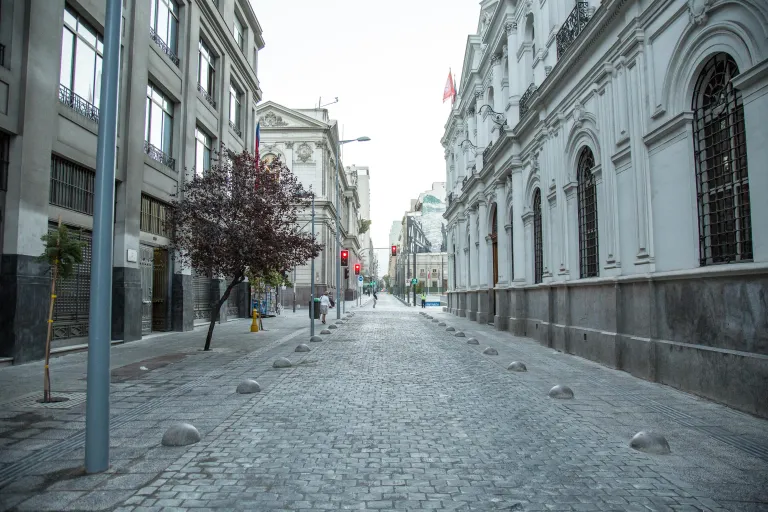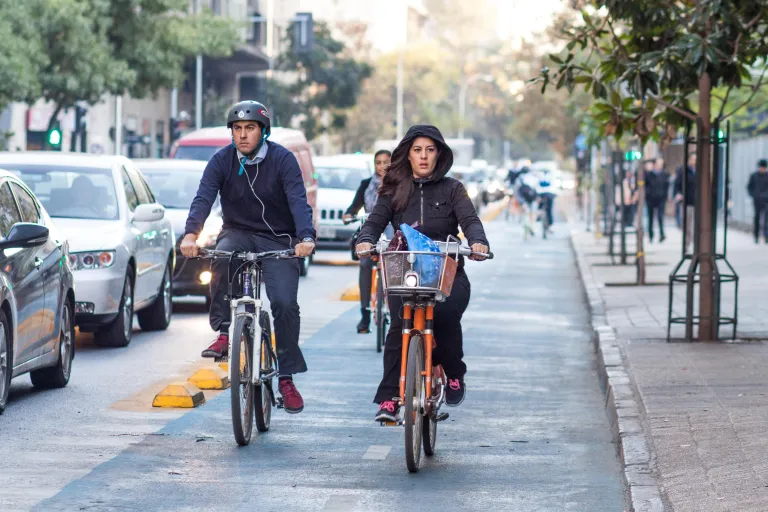Bus Rapid Transit (km) 92 | BRT Passengers (per day) 50,000 | Bike Share Stations 175 | Total Bike Share Bikes 2600 | Total Cyclist (per day) 40,000| Cycling Infrastructure (km) 36
Writer Unknown
Santiago, the Chilean capital with an urban population of five million, and a metro area population of over seven million, is a beautiful old-world city enjoying a modern day renaissance. Despite the city’s attempt to improve transport for its people through its BRT Transantiago in 2006, it had been lagging behind other cities in the region on cycling and walking.
However, between 2015-16, non-motorised (walking and cycling) and public transportation in Santiago underwent significant development, transforming the city into a haven for its citizens. Santiago was thus announced as the winner of the 2017 Sustainable Transport Award (STA). The city will be hosting ITDP’s annual sustrans summit MOBILIZE between June 28 – 30, 2017.
Our Indian government also aims to implement such people-friendly mobility initiatives through the Smart City Mission, and can draw on the lessons of Santiago at MOBILIZE. Amongst other attendees from India, Sameer Sharma, Additional Secretary & Smart City Mission Director, MoUD will also be at the summit. As a speaker, he will be sharing his thoughts on how a city can be made inclusive through principles of mobility and access.
Car ownership has soared in Chile over the past decade along with the economy, with the number of cars bough increasing each year from 2003 to 2014. Greater Santiago is now home to seven million people, and four million cars. However, the last few years have seen considerable changes. Owing to the significant improvements in transit, cycling & walking, and the overall public realm, as a result of the city’s Integrated Mobility Plan, more Santiaguinos have shifted to these modes to get around their city.
Santiago’s Calle Aillavilú, in the central market of the city, has been transformed from a derelict, car-congested and unregulated parking lot to a pedestrian-friendly oasis. The street was repaved, lighting improved, new trees were planted, and most importantly, cars were removed. Except for the scheduled delivery of goods, no motorized traffic is allowed. Calle Placer, one of the busiest pedestrian streets during a popular weekend market, is now completely closed to cars on the weekends, with a 2.2 million USD investment by the city for improved sidewalks, lighting, and sanitation.
On Sunday mornings, cars are banned from 40 kilometers of Santiago’s roads. Around 30,000 people take to those vehicle-free streets on bikes, skateboards, rollerblades, or simply on foot. The Car-Free days in many Indian cities have also been highly successful and can be scaled up, learning from Santiago.

The redesigned Plaza de Armas in the city centre, to prioritise pedestrians
Other public space improvements include an investment in 100 sqm. of new green spaces in historic residential neighborhoods, revitalizing a previously abandoned area, and the re-design of the Historical Center’s main streets, featuring more sidewalk space, improved lighting, beautification, and a “complete streets” redesign for public transport exclusive corridors in the most active pedestrian zone in the country.
Cycling mode share has doubled since 2006, with the number of cyclists on major routes growing by 25 percent a year for the past two years. The City has backed up this achievement with new sustainable transport policy changes and education programs. In April 2015, the National Ministry of Housing and Urbanism created a detailed standard of design for high quality cycle lanes, even piloting it in a major street near the presidential palace. The policy redistributes road spaces to create more space for cyclist. This standard was quickly adopted by Santiago, and the city has managed to increase cycling trips from a negligible 150 per day to over 5000 per day.

This number is expected to further rise with the growing popularity of BikeSantiago, the city’s bike share program, which accounts for 50 percent of the increase. Santiago also gave support to BMov Trici, a free bicycle taxi in the historic city center operated by a private company, supported by advertising, that encourages cycle use and provides a non-motorized alternative to taxis.
The city has also adopted a pilot program of cycling games in kindergarten to help introduce cycling early in life and a traffic education program at primary schools to create better cyclist behavior.
Cycle Lanes in Santiago

With all these efforts to improve the quality of life for the people, Santiago won STA 2017 and will be the site of Mobilize 2017, ITDP’s annual Sustainable Transport Summit, supported by the Volvo Research and Education Foundations. This event will give international transportation researchers and professionals an opportunity to experience this emerging city as a learning lab for best practices in sustainable transport. For more information, visit mobilizesummit.org
The cycling games program intends to familiarize children with cycling culture and safety
